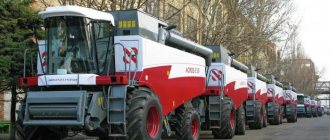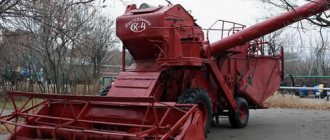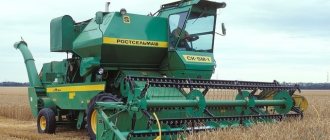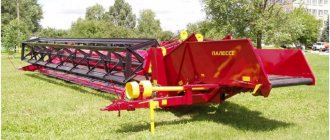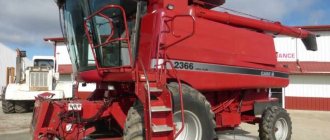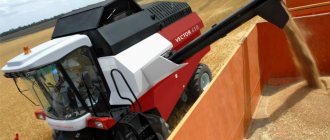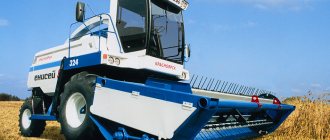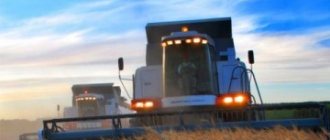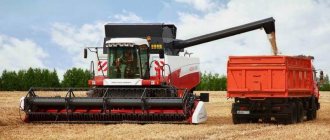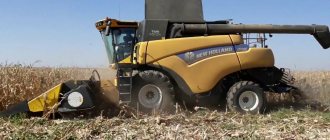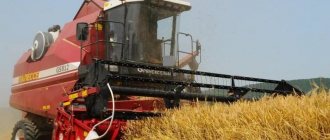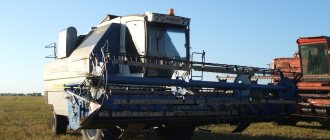In Russia they make excellent models of grain harvesters (you can look at the photo to understand what they are) that produce bread for us. The technical characteristics of domestic combines are highly rated in agriculture, and the importance of these machines during the harvesting period is difficult to overestimate. A description and information about what a combine harvester does will help you understand the principle of operation.
Today it is quite difficult to imagine your life without a gate. Especially if you are the owner of a private house and at the same time the owner of a car. Gates are also in great demand in industrial areas, educational institutions and medical institutions.
Gates come in various variations, but according to sales statistics, sliding gates occupy a large share of the market. You can order such a product ready-made, or you can convey to the manufacturer your wishes regarding the required dimensions, materials used and appearance of the gate. For projects proposed by the customer, specialists use only hot hand forging.
What kind of technique is this
Grain harvesters are highly specialized agricultural machines that are used for harvesting grain crops. Work processes are fully automated, which facilitates fast work completion and allows you to quickly finish cleaning. This is important to preserve the quality and beneficial properties of the collected raw materials. Grain harvesting machines combine the functions of the following modifiers:
- thresher;
- header;
- winnower
The first combine harvesters appeared in the United States in the 19th century. These were carts on wheels that facilitated the work of cutting the stems, clearing them of grain and sifting the shells. The appearance of modern cars has changed significantly. They are large in size and have high productivity, but the anthropogenic load on the soil is low. The equipment carefully processes chaff and grain, and the participation of the combine operator in the harvesting process is minimal.
Today, the range of cleaning machines is so wide that it is difficult to determine which device is better. Each type has its own technical characteristics, features of operation, maintenance, and device.
How cleaning equipment works
The classic operating principle of a combine harvester can be described as follows. The reel tilts the ears, and the knives or other cutting mechanism performs the cutting. The plant mass enters the auger, where special devices called fingers direct it into the chamber, then to the drum. All foreign objects that fall, such as stones, are thrown back by the propeller blades into a special compartment. Along the deck, the raw material passes through the drum, where the grain is knocked out with notches. After this, the straw moves further and collides with a bar standing across it. This is how the resulting grain is separated from the stems. The straw is crushed or enters the stacker, and the grain falls down, passing through a key mechanism and a grate, where it is finally cleaned.
Classification
Grain harvesting equipment is divided according to several parameters:
- method of movement;
- direction of compressed raw materials;
- main mechanism of the separating threshing unit.
According to the first parameter, machines can be:
- Self-propelled. This is a mechanism on wheels or tracks, driven by its own internal combustion engine.
- Trailed. This is an installation that is connected to the draft equipment (most often a tractor) through a hydraulic drive or cardan shaft.
- Mounted. Usually found in small models. Using an adapter, you can turn, for example, a walk-behind tractor into a real small harvester. This technique can be chosen for a personal garden.
According to the direction of the cut raw materials, they are distinguished:
- cross-flow machines;
- G and T-shaped;
- longitudinal-flow technique.
How to make a mini grain harvester with your own hands - assembling a homemade device
In principle, a homemade mini grain harvester can be made on the basis of any tractor, for example, the T-40. U
These units have all the necessary components that are necessary for the full operation of the combine, i.e. sufficiently powerful engine, wheelbase, driver's seat, etc.
Due to the fact that grain harvesting is carried out in the summer, the tractor cabin can be removed for greater driver comfort.
The main essence of the modification is to add a header to the tractor structure. You can take KPKU-75, whose working width is approximately three meters, or use another one. The Internet is full of advertisements for the sale of such components, so there should be no problems finding them.
For better balancing, you need to provide some kind of counterweight (water tank or gas cylinders) behind the tractor. As a tractor, you can easily use the Terrion, Challenger, New Holland or MTZ 80 model. We wrote about the latter in detail in this article.
How different models work
Depending on the design of the threshing separating unit, threshing devices are:
- rotary type;
- drums;
- mixed.
The features and mechanism of work of these groups can be considered in more detail.
Rotary
In the design of a rotary machine, the threshing unit is represented by a rotor. Rotating, it creates centrifugal force, which contributes to threshing of grain. These are convenient and productive combines, so they are perfect for processing large, high-yielding fields. An additional advantage is low labor intensity, reduced number of drives and rotating mechanisms. However, there are some disadvantages:
- the equipment cannot work with wet raw materials;
- The machines show their greatest performance only in dry, hot areas;
- expensive maintenance and increased resource consumption.
On a note!
The rotary grain harvester is suitable for large agricultural enterprises. Since the price of such equipment is high, it is not advisable to purchase it for personal use.
Drums
The design of such combines (they are also called keyboard harvesters) can be called classic. At the front of the machine there are knives that cut the chaff and transfer it to the reel. It collects the stems and moves them to the header. With the help of rotating augers, the ears are moved into the conveyor pipe, and then into the threshing department. The threshing drum threshes the raw materials. The portion separated from the chaff is poured onto the screen through the deck, and the unthreshed parts undergo another processing. In this case, the stems are cut or go into a storage bin, and the grains are winnowed and poured into a special compartment. From there they can be poured into truck bodies. At the same time, the productivity of drum technology is two or three times less than that of rotary technology.
How we are the first in the world to robotize forage harvesters
Recently, my colleague told how we robotize combine harvesters and what we have learned this season. Harvesting of forage crops begins and we are actively mastering forage harvesting equipment. A forage harvester is a technically more complex and powerful machine. In conjunction with it there are several vehicles for harvesting (tractors with trailers, trucks, silage trucks). Only experienced machine operators with several years of experience behind them are allowed to operate such equipment.
Operating a combine while harvesting feed corn is similar to driving in a car in thick fog, only instead of fog, there is a tall green wall of plants along the entire route from which a boar, a pole or a person can jump out. After grinding a person (the story is in my last article), the combine operators turn gray and can no longer work. In addition, in this “green fog” you must be able to avoid crashing into a silo truck driving nearby, monitor the accuracy of loading the silo with a trunk up to 7 meters long, from which 50-60 kg of silage per second flies out, and fill the van evenly so that it does not drove half empty back and forth.
In fact, one combine operator works for three, monitors the corn harvesting process (one workplace), drives the equipment (second workplace), and loads the silo truck (third workplace). As a result, something suffers. If you drive poorly, you can break expensive equipment (the minimum price of a forage harvester is 16 million rubles, there are models for 50 million), so the quality of harvesting and loading usually deteriorates.
We automate most of the work, now I’ll tell you what difficulties we overcome and what we do.
No visibility
The height of ripe corn is on average 2-2.5 meters, the height of the combine is 2.5 meters, the machine operator is most often at a level slightly higher than a person standing on the ground and sees only plants in front of him, he essentially no longer sees further than his nose, and so on throughout the entire working day, and this is a 12-hour shift, few can withstand such strain on the eyes and maintain the pace of assembly, and pigs or a pole may jump out on the way!
There are combines, for example KRONE, with a telescopic cabin that rises to a height of up to 3 meters, or Acros RSM-142 with a height of 4 meters, but this is rather an exception to the rule.
Therefore, only experienced combine operators who have worked for 3-4 seasons can operate such a combine.
Losses during operation
Unlike grain harvesters, a forage harvester cannot store the crop in a bunker, but immediately releases it through an unloading trunk into a vehicle driving nearby. As I said, the silage ejection speed can reach 50 kg per second, depending on the model of the combine, the length of the trunk is 5-7 meters. I drove a little sideways away from the car or slowed down and lost half a ton of silage in 10 seconds. On average, up to 7-10% of the harvest remains on the field. Nobody collects the lost silage anymore; losses on fuel and lubricants will be much greater. The video shows how the silage spills out if you move the trunk a little.
Uniform filling of the van
In a team with one combine there are up to 7 cars, one car is filled in about 20 minutes. In a day they can make over 10 trips to the silo. It all depends on the length of the delivery arm. If the field is near the pit, then the arm is short and more trips can be made for unloading; if further, there are fewer trips and here it becomes very important to properly fill the van (silage truck) so that it does not carry air. I brought half of the trailer, but I think I lost it on fuel; the combine operator must guide the trunk as correctly as possible in order to evenly fill the silo truck.
What can we automate in forage harvesters?
As mentioned above, only experienced combine operators are allowed to operate such combines.
Almost all effective machine operators trained under the USSR, after which the technological secrets of this civilization were lost. Specifically, training has weakened, and the “young” people who come in naturally work worse. This is normal for almost all working professions, but here our robot is in great demand primarily because of this effect. Second, our robot sees the edge, obstacles on the field, and sees other equipment. The work of the combine operator is simplified as much as possible; now he can monitor the technical condition of the combine and the calibration of the corn fraction that is most suitable for this type of livestock.
Also, our robot can completely and evenly, and most importantly accurately, fill the silo tank, this reduces losses on fuel and lubricants and reduces harvesting losses to zero.
The norm is considered to be a loss of 7% of the harvest during harvesting, if they are reduced to zero, then since silage is made mainly not for sale, but for feeding our livestock, we can reduce the sowing of corn by 7% and give it to wheat, which is more profitable. Let's say, if 1000 hectares are allocated for corn, of which 70 hectares are allocated for wheat, then even according to minimal estimates, with a harvest of 30 centners per 1 hectare, we will collect 210 tons, and this is approximately 1.5 million rubles in direct profit. At the same time, due to more complete assembly, fuel consumption is reduced by reducing the number of trips from the silo to the field.
How we train neural networks to analyze corn harvesting scenes
Corn is harvested using special attachments for row crops. For this case, an operating mode is provided in which the combine tries to hold the header in the middle of the row spacing. Having received a frame (scene) segmentation map and knowing the position of the header, you can find the so-called vanishing point and calculate the deviation of the header tooth from the required position.
Unlike wheat, where we monitor the edge of the harvested field and drive the harvester along the edge, here the task of the neural network is to see the row spacing between the plants. The neural network perfectly sees the rows between the corn, unlike a person, the camera is located above the crop, and at the same time it does not get tired.
Images come to us in video stream format, or as separate images. The data is processed and stored in Cognitive Agro Data Factory. In addition to raw data from the camera, there are also target marked frames, which, if necessary, can be added to the training dataset.
To more accurately select possible harvesting scenes, it is necessary to correctly compose the training dataset. In addition to real images obtained from the camera during the harvesting process, an approach is used to generate synthetic images using an augmentation procedure based on natural images.
The network accepts a 3-channel RGB image as input. Further, in the process of training the neural network, brightness/color distortions in HSV space, local distortions of channels in HSL space are applied to the input tensor - the procedure for adding artificial shadows, geometric distortions and adding noise. Selection of augmentation parameters is a non-trivial procedure that requires a detailed analysis of scenes obtained in real conditions.
The trained network is capable of producing segmentation maps that define the row space.
Hay cleaning
In addition to silage, forage harvesters are also used to collect haylage using a pick-up attachment.
The harvesting process is similar to corn, the only difference is that the combine goes along the windrow. The windrow may not differ in color from the total mass and the combine operator may often run idle. For example, in the video above you can see that the windrow is practically indistinguishable from grass and how precisely the combine operator needs to drive the machine along the windrow and at the same time constantly monitor the process of loading the haylage into the truck. The work is very intense; by the end of a 12-hour shift, combine operators simply collapse; they can only handle a full shift if they have at least 3-4 seasons of experience.
If the combine operator is inexperienced, then idle work is a waste of fuel and lubricants. A forage harvester, unlike a grain harvester, spends only 10% of fuel and lubricants on the movement of the combine itself, the remaining 90% goes to cutting, chopping, pulling, throwing silage or haylage. Therefore, it is very important to work with a fully loaded combine.
The neural network does a great job with windrows, an example of how the network sees windrows.
Here our system can help the combine operator in driving the combine along the windrow, also our robot can completely and evenly, and most importantly accurately fill the silo tank, this reduces losses on fuel and lubricants and reduces harvesting losses to zero, the combine operator becomes the operator of the combine, and takes on all the work yourself on autopilot.
We are now developing feed corn, sunflower, and haylage. At the end of the season, if you are interested, we will tell you how our robots coped with forage harvesters.
PS If your agronomist is not on Habré, but he is interested, then you can find contacts here: promo.cognitivepilot.com and discuss in detail which combine harvester requires which specific set of equipment, approximately how much it costs, and how you can quickly see and test it.
The best brands
As is the case with any special equipment, there are recognized leaders among manufacturers of harvesting machines. The most reliable companies producing high-quality combines are:
- Combine plant in Taganrog. Manufactures the SK-6 Kolos harvesting machine. The device is undemanding to the quality of fuel and lubricants, has direct access to the main parts, so they can be replaced without dismantling the entire mechanism.
- Rostselmash. Manufactured by the Nova S300 harvester. It is one of the best machines for harvesting not only grains, but also legumes and rapeseed crops. The threshing machine is 1.2 m long and processes about 9 tons of grain per hour.
- Agromet. The plant produces the Bizon grain harvester. The equipment is equipped with a 5 m header and a thresher. The combine can be equipped with special trolleys and devices for collecting sunflowers. The car is highly comfortable, since operating settings are made by simply pressing the touch screen, and the steering wheel is equipped with a hydraulic booster.
- Claas. The company is known for its Tucano 450 combine harvester. This is a self-propelled, durable machine that has shown efficiency and high speed in the most difficult fields. Moreover, all models are equipped with comfortable cabins, touch-sensitive instrument panels, and are easy to operate and maintain.
On a note!
All of these models have received recognition from farmers and other farmland owners. These machines are durable, comfortable, and have excellent build quality. They are easy to maintain and easy to repair.
Combine harvesters are essential equipment in agriculture. When choosing it, you should take into account the size of the area being processed and the operating principle of a particular type of machine.
Carrot harvester: classifications, leading manufacturers
Agricultural techniques for sowing, caring for and protecting carrots using mechanized methods have reached a level where this area has become profitable. But harvesting is a little more complicated. Many farms refuse to grow this crop due to the lack of harvesting equipment, and the cost of manual labor for harvesting carrots accounts for at least half of all expenses. Harvesting equipment seems so expensive that the farmer believes it is more profitable to use human labor. What are the advantages of a carrot harvester and how justified is its purchase?
Classification of carrot harvesters
The market offers many modifications of combine harvesters from different brands. These are classic domestic, reliable European, high-tech Japanese and analog Chinese models. All of them are divided into two groups depending on the principle of cleaning, namely:
- with lifting by the tops;
- with preliminary mowing of the tops.
The first group refers to harvesters of the lifting type. The basic principle of operation is to dig up the carrots with a fork, pull out and feed the carrots by the tops using a conveyor and transfer the carrots to the belt, where the tops are torn off from the root crop. After this procedure, the carrots go to the elevator or bunker.
During this harvesting method, the risk of carrot damage is reduced several times. The forks of this group of combines can be active or passive, and are driven into the ground both vertically and horizontally. But regardless of their design features, losses during cleaning are minimized.
The second group of combines works on carrot beds with pre-mown tops, or cut with a special machine. After this, the carrots are dug out of the ground using special cutters and transferred to a mesh chain, which cleans the carrots from any remaining soil. Digging forks in such combines are used passive, and this design is not able to cope with cylindrical root crops.
This method of harvesting carrots has a number of disadvantages. These are losses and damage during digging. Damaged carrots are poorly stored and lose their marketable appearance, so they are only suitable for processing. When using carrots for processing, elevator or bunker combines are used. Such combines have significant advantages in terms of harvesting speed.
If carrots are intended for long-term storage, then unloading from the combine should occur immediately into special containers to minimize damage. In some cases, elevator combines are also used, but with a special extinguishing device when feeding into the elevator and the additional use of vehicles with containers for storing carrots.
Based on the type of aggregation, carrot harvesters are divided into two types:
- towed devices (non-self-propelled);
- self-propelled combines.
Semi-mounted or trailed combines are the cheapest in their segment. To operate such a combine, draft equipment with a power of at least 100 hp is used. Such combines are capable of harvesting 2-4 rows. Loading is carried out first into a bunker, elevator, directly into a container or trailer.
Self-propelled harvesters operate with up to 6 rows. The simplest models are bunker and elevator type. The most modernized models are equipped with carrot washers, platforms for pickers, fall arresters, and inspection tables. The choice of a combine harvester modification and the availability of the necessary options depends on many factors such as:
- land area;
- purpose of the harvested crop;
- storage method;
- availability of draft equipment;
- climatic conditions;
- soil characteristics.
Sometimes the standard components of a harvester are not enough. To avoid this problem, it would be a good idea to familiarize yourself with all the offers from popular manufacturers of equipment for harvesting root crops.
Leading manufacturers of carrot harvesting equipment
The following brands of carrot harvesting equipment are the most widely represented on the agricultural machinery market today, and have already won their rightful place:
- ASA Lift
- Jones Engineering
- Grimme
- Simon
- Nobels
- Dewulf
Each unit of harvesting equipment from these manufacturers is constantly modernized, taking into account the requirements of modern farms. Carrot harvesters are becoming more productive and profitable.
Economic justification for the profitability of the combine
The cost of a carrot harvester often seems prohibitive for the average farmer. The price of some models, which are capable of harvesting about 40 hectares, reaches 2,000,000 rubles and more. As an expense item for cultivating such an area of land, such an amount is unreasonable. But if we take into account that the combine will operate for at least 10 years, then the cost item is reduced to 200,000 rubles per year. Per 1 hectare of land, the cost of harvesting carrots will not exceed 5,000 rubles.
Even if we take into account fuel consumption and depreciation, the final figure will not exceed 10,000 rubles per 1 hectare. Harvesting 1 hectare of carrots will require at least 40 people who will work 10 hours. If you pay everyone 1,000 rubles, then the cost of cleaning an area of 1 hectare using manual labor will be 40,000 rubles. Accordingly, harvesting a carrot field of 40 hectares will cost 1,600,000 rubles per year. Over 10 years, this amount amounts to 16,000,000 rubles. If we return to the cost of carrot harvesting equipment, the economic advantages are obvious.
